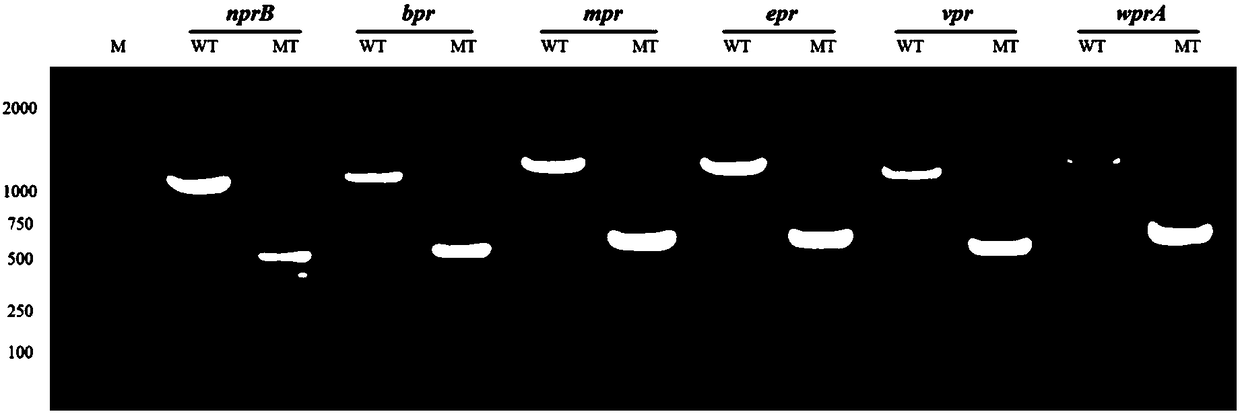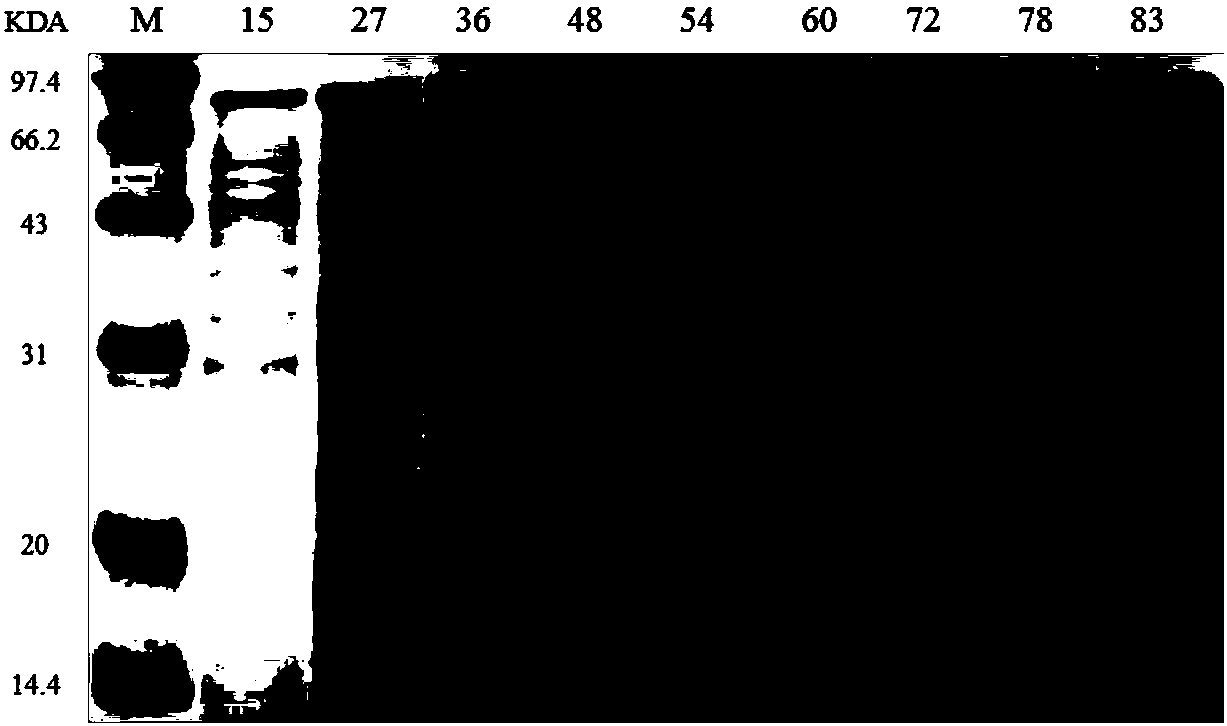Bacillus subtilis used for high-efficiency expression and high-density culture of pullulanase
A Bacillus subtilis, high-density culture technology, applied in the field of fermentation engineering, can solve the problems of low exogenous protein expression, inability to achieve high bacterial density and the like
- Summary
- Abstract
- Description
- Claims
- Application Information
AI Technical Summary
Problems solved by technology
Method used
Image
Examples
Embodiment 1
[0026] Embodiment 1: Construction of knockout plasmid
[0027]According to the gene sequence of Bacillus subtilis, the sgRNA used to specifically target the nprB, bpr, mpr, vpr, epr and wprA genes was designed, based on the CRISPR / Cas9 knockout plasmid pHY300dsrf1 constructed in our laboratory earlier (the construction of the plasmid The method was disclosed in the paper "Multigene disruption in undomesticated Bacillus subtilisATCC6051ausing the CRISPR / Cas9system" in 2016), and primers were designed to amplify the original sgRNA by PCR and to obtain six modified knockout plasmids; then the genome of Bacillus subtilis WS5 was used as a template , PCR amplified the homologous repair arm fragment with XbaI restriction site, connected to the pMD-18T cloning vector, and transformed into JM109 for amplification. The cloning vector and knockout plasmid with homology arms were digested with XbaI respectively, and then T4 ligase was ligated overnight to obtain six knockout plasmids pHY...
Embodiment 2
[0033] Embodiment 2: Bacillus subtilis transformation method
[0034] Dip the frozen Bacillus subtilis with an inoculation loop, then streak on the LB plate, and cultivate overnight at 37°C for activation. Pick a single colony and inoculate it in 5 mL LB liquid medium, and culture overnight at 37°C for 18 hours. Take a certain amount of overnight culture into 4.5mL of GMI, so that the OD600 value reaches 0.1-0.2, leaving 4.5mL of mixed bacterial liquid. Shake culture at 200 rpm at 37°C, measure OD600 every 20 minutes, when OD600 reaches 0.4-0.6 (about 60-90 minutes); continue to shake and culture for 90 minutes, draw 0.05mL bacterial liquid into a sterile test tube containing 0.45mL preheated GMⅡ medium; shaking at 37°C for 90 minutes, at this time, many competent cells formed in the culture; add 1 μg of plasmid (15-20 μl), shake and culture at 37°C for 30 minutes; centrifuge to remove most of the supernatant, resuspend the cells, and spread on Incubate overnight at 37°C on ...
Embodiment 3
[0040] Example 3: B. subtilis WS5 gene knockout
[0041] The plasmids pHY300dnprB, pHY300dbpr, pHY300dmpr, pHY300dvpr, pHY300depr and pHY300dwpr were used to knock out the six genes nprB, bpr, mpr, vpr, epr and wprA in the genome of B. subtilis WS5, respectively. Using the method in Example 2, the knockout plasmid was transformed into Bacillus subtilis competent cells, spread on LB solid medium (containing 20 μg / mL tetracycline), and cultured overnight at 37°C. Pick positive clones, extract the genome, use the genome as a template colony PCR to amplify the homologous repair fragment, and then carry out Xho I digestion verification at 37°C. Since the gene knockout strain inserts the Xho I enzyme cutting site at the gene break when performing genome homology repair, it can be cut by the Xho I endonuclease, while the wild type will not be cut, enzyme digestion verification The correct knockout bacteria were used to eliminate the knockout plasmid at 51°C ( figure 1 ). Six gene ...
PUM
 Login to View More
Login to View More Abstract
Description
Claims
Application Information
 Login to View More
Login to View More - R&D
- Intellectual Property
- Life Sciences
- Materials
- Tech Scout
- Unparalleled Data Quality
- Higher Quality Content
- 60% Fewer Hallucinations
Browse by: Latest US Patents, China's latest patents, Technical Efficacy Thesaurus, Application Domain, Technology Topic, Popular Technical Reports.
© 2025 PatSnap. All rights reserved.Legal|Privacy policy|Modern Slavery Act Transparency Statement|Sitemap|About US| Contact US: help@patsnap.com



